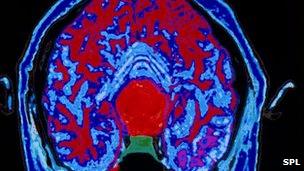Switching on a light in the brain
- Published
- comments

A new technique known as optogenetics is lighting up the field of neuroscience. The idea involves genetically engineering neurons to respond to light, and then using powerful lasers to stimulate and control their expression.
The technique holds out the promise of new treatments across a range of previously intractable neurological disorders, from Parkinson's disease to epilepsy. And that promise is already being turned into tangible benefits - if only at this early stage in animal models .
Earlier this month researchers at University College London's Institute of Neurology used optogenetics to suppress epileptic seizures in rats. The study, published in the journal Science, involved inserting a light sensitive gene (taken from a species of algae) into the genetic code of a small population of neural cells associated with focal seizure.
The researchers used a virus to deliver the gene, which expresses the light-sensitive protein halorhodopsin. When they switched on the lights - from a 561-nanometre laser via a fibre-optic cable - the halorhodopsin pumped negatively charged chloride ions into the cell, suppressing activity and making it much harder for the neuron to fire.
"After a fortnight," lead author Dr Robert Wykes says, "the number of seizures dropped dramatically and the animals were effectively cured. It's the first time a gene therapy has been used in combination with optogenetics so its very exciting".
That excitement is shared by the Professor of Neuroscience at Oxford University, Colin Blakemore, who points to optogenetics as one of the key new technologies fuelling a big leap forward in brain science.
"There's no doubt that neuroscience is going through a remarkable purple patch at the moment, and much of that excitement comes from the combination of the knowledge coming from genetics with these new ways of manipulating gene expression in neural cells. That's really marching ahead very fast and it's driving an enormous amount of discovery."
The pioneer of optogenetics, Professor Gero Miesenbock, is now so famous he's been immortalised as a manga comic character and as a children's action figure. "Dr Gero" is a brilliant, but evil, scientist whose skull has been replaced with a plexi-glass dome so that his thoughts can be controlled with light.
"It's exactly what I do," says the real Professor Miesenbock: "optical mind control. But in contrast to my evil twin I don't lust after world domination. I control the brain in order to understand how it works."
Working in fruit flies - whose skulls are thin enough for light to penetrate easily - Professor Miesenbock has been able to identify a number of individual neural cell-types responsible for a range of activities. But as we learn more about the specific function of neurons, he says, we create new opportunities to intervene.
"One can think of many different conditions in which the ability to interfere in the function of specific neural cells could lead to very very powerful new therapeutic avenues."
It is early days, but as the UCL team's work in an animal model of epilepsy shows, optogenetics has enormous potential to deliver new treatments across a wide range of debilitating neurological conditions. It may be years, perhaps decades, before we have the first optogenetic treatment for epilepsy, but Gero Miesenbock is confident there is at least a 561-nanometre laser light at the end of the tunnel.